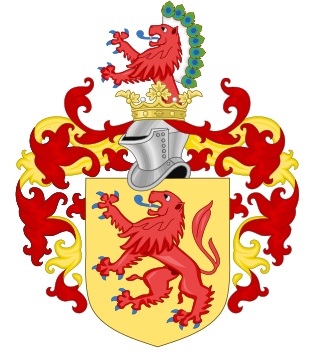
The House of Habsburg, also known as the House of Austria, was one of the most prominent and important dynasties in European history.
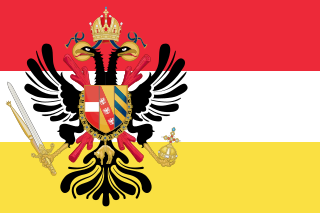
The Austrian Netherlands was the territory of the Burgundian Circle of the Holy Roman Empire between 1714 and 1797. The period began with the acquisition by the Austrian Habsburg monarchy of the former Spanish Netherlands under the Treaty of Rastatt in 1714. It lasted until Revolutionary France annexed the territory after the Battle of Sprimont in 1794 and the Peace of Basel in 1795. Austria relinquished its claim on the province in 1797 through the Treaty of Campo Formio.

The House of Lorraine originated as a cadet branch of the House of Metz. It inherited the Duchy of Lorraine in 1473 after the death without a male heir of Nicholas I, Duke of Lorraine. By the marriage of Francis of Lorraine to Maria Theresa of Austria in 1736, and with the success in the ensuing War of the Austrian Succession (1740–1748), the House of Lorraine was joined to the House of Habsburg and became known as the House of Habsburg-Lorraine. Francis, his sons Joseph II and Leopold II, and his grandson Francis II were the last four Holy Roman emperors from 1745 until the dissolution of the empire in 1806. The House of Habsburg-Lorraine inherited the Habsburg Empire, ruling the Austrian Empire and then Austria-Hungary until the dissolution of the monarchy in 1918.

The House of Rohan is a Breton family of viscounts, later dukes and princes in the French nobility, coming from the locality of Rohan in Brittany. Their line descends from the viscounts of Porhoët and is said to trace back to the legendary Conan Meriadoc. Through the Porhoët family, the Rohans are related to the Dukes of Brittany, with whom the family intermingled again after its inception. During the Middle Ages, it was one of the most powerful families in the Duchy of Brittany. The Rohans developed ties with the French and English royal houses as well, and they played an important role in French and European history.

The House of Leszczyński was a prominent Polish noble family. They were magnates in the Polish–Lithuanian Commonwealth and later became the royal family of Poland.

The House of La Tour d'Auvergne was an important French noble dynasty. Its senior branch, extinct in 1501, held two of the last large fiefs acquired by the French crown, the counties of Auvergne and Boulogne, for about half a century. Its cadet branch, extinct in 1802, ruled the duchy of Bouillon in the Southern Netherlands from 1594, and held the dukedoms of Albret and Château-Thierry in the peerage of France since 1660. The name was also borne by Philippe d'Auvergne, an alleged collateral of the original Counts of Auvergne, and was adopted by the famous soldier Théophile Corret de la Tour d'Auvergne, who descended from an illegitimate line of the family.

The House of Croÿ is an old European noble family of princely and historically sovereign rank, which held a seat in the Imperial Diet from 1486, and was elevated to the rank of Princes of the Holy Roman Empire in 1594. In 1533 they became Dukes of Arschot and in 1598 Dukes of Croy in France. As a former ruling and mediatized family, it belongs to the Hochadel. In 1913, the family had branches in Belgium, France, Austria and Prussia.
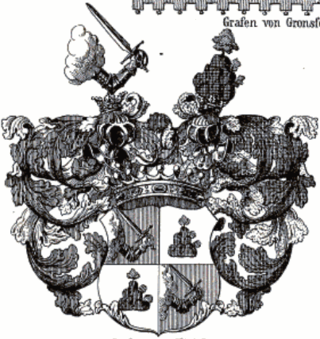
The Hügel family is a German noble family originating from Württemberg. In 1790, members of the younger branch of the family were elevated to the rank of Imperial Baron by Leopold II, while in 1801 members of the elder line of family were raised to the same rank by Francis II, Holy Roman Emperor. On 13 June 1879 the elder branch of the family was raised to the hereditary title of Count in the Kingdom of Württemberg by King Charles I. This comital branch of the Hügel family was closely related to the Dukes of Teck, morganatic branch of the House of Württemberg. Countess Amalie von Hügel was paternal aunt of Queen Mary.

The Duchy of Luxembourg was a state of the Holy Roman Empire, the ancestral homeland of the noble House of Luxembourg. The House of Luxembourg became one of the most important political forces in the 14th century, competing against the House of Habsburg for supremacy in Central Europe. They would be the heirs to the Přemyslid dynasty in the Kingdom of Bohemia, succeeding to the Kingdom of Hungary and contributing four Holy Roman Emperors until their own line of male heirs came to an end and the House of Habsburg received the territories that the two Houses had originally agreed upon in the Treaty of Brünn in 1364.

The County of Luxembourg was a State of the Holy Roman Empire. It arose from medieval Lucilinburhuc Castle in the present-day City of Luxembourg, purchased by Siegfried, Count of the Ardennes in 963. His descendants of the Ardennes–Luxembourg dynasty began to call themselves Counts of Luxembourg from the 11th century onwards. The House of Luxembourg, a cadet branch of the Dukes of Limburg, became one of the most important political forces of the 14th century, contending with the House of Habsburg for supremacy in the Holy Roman Empire.
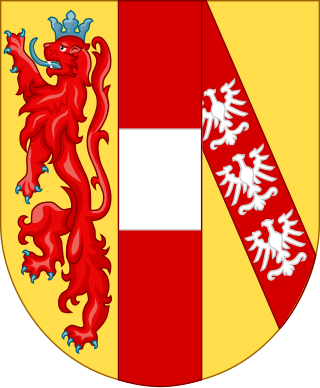
The House of Habsburg-Lorraine originated from the marriage in 1736 of Francis III, Duke of Lorraine and Bar, and Maria Theresa of Austria, later successively Queen of Bohemia, Queen of Hungary, Queen of Croatia and Archduchess of Austria. Its members form the legitimate surviving line of both the House of Habsburg and the House of Lorraine, and they inherited their patrimonial possessions from the female line of the House of Habsburg and from the male line of the House of Lorraine.

The Count of Hainaut was the ruler of the county of Hainaut, a historical region in the Low Countries. In English-language historical sources, the title is often given the older spelling Hainault.

The House of Merode is one of the most prominent families of the Belgian nobility. It originates from the village of Merode, which is now in the municipality of Langerwehe in Germany. Over the past five centuries, different branches bore noble titles and had estates on the territories of the modern-day states of Germany, Belgium, the Netherlands, France and Austria. Through marriage, the house is connected with many prominent European noble families. The House of Merode played an important role in the history of the Southern Netherlands and the Kingdom of Belgium.
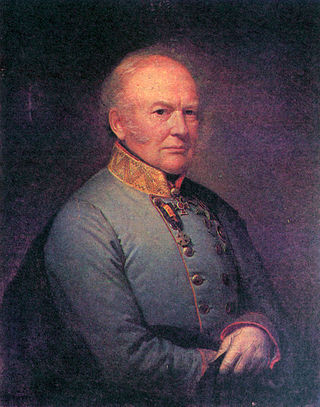
Karl Ludwig, Count of Ficquelmont was an Austrian aristocrat, statesman and Field marshal of the Austrian Imperial army of French noble origin.
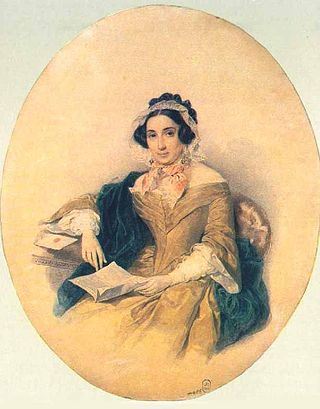
Dorothea "Dolly" de Ficquelmont, born Countess Dorothea von Tiesenhausen, was a Russian writer and salonist. A granddaughter of the Russian war hero General Prince Kutuzov, she was a Russian aristocrat of German Baltic origin, and later a member of the Austrian nobility as the wife of Count Karl Ludwig von Ficquelmont.
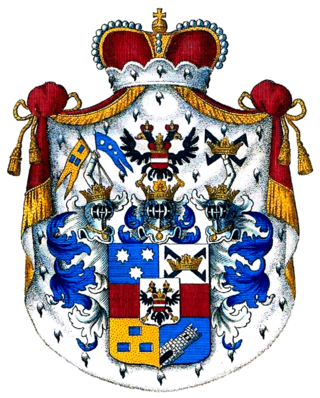
The House of Clary und Aldringen, also known as Clary-Aldringen, is one of the most prominent Austro-Hungarian princely families. Originally from Friuli, Northern Italy, one branch of the family moved to the County of Tyrol around 1500 and to the Kingdom of Bohemia around 1600, where it became one of the leading families of the Bohemian nobility. It produced several notable Austro-Hungarian statesmen, military officers and diplomats.
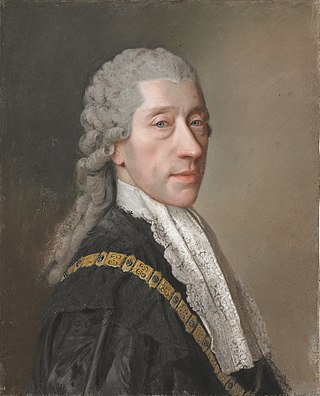
Wenzel Anton, Prince of Kaunitz-Rietberg was an Austrian and Czech diplomat and statesman in the Habsburg monarchy. A proponent of enlightened absolutism, he held the office of State Chancellor for about four decades and was responsible for the foreign policies during the reigns of Maria Theresa, Joseph II, and Leopold II. In 1764, he was elevated to the noble rank of a Prince of the Holy Roman Empire (Reichfürst).

The Palais Ficquelmont are palatial residences which belonged to the counts de Ficquelmont, one of Lorraine's most illustrious aristocratic dynasty that has spread across Europe as the Duchy merged into the Habsburg Empire then into the Kingdom of France and once again after the burst of the French Revolution.
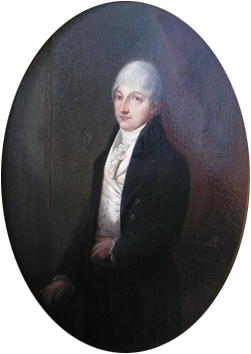
Frédéric Auguste Alexandre de Beaufort-Spontin, 1st Duke of Beaufort-Spontin, was a member of the House of Beaufort-Spontin, a Belgian noble family that opposed Napoleon I of France.

The House of Beaufort-Spontin is a noble family which held prominent posts under the Holy Roman Emperors in the Austrian Netherlands, their family seat having originally been in Namur. The most notable member of the family was Frederic August Alexander of Beaufort-Spontin, who became the first Duke of Beaufort-Spontin in 1782. Cadets bear the title of Count or Countess. The members of this family now reside in Austria and were members of the Austrian nobility, but their origins are in territories in what is today Belgium.























